|
Page 2 of 2

Distortion
On DX cameras the lens is practically free of distortion.

The chart above has a real-world size of about 120x80cm.
Vignetting
Being a FX lens, the Nikkor profits from the sweet spot advantage on DX cameras. So, even though it's a very fast lens, it shows only moderate vignetting wide open, which is reduced to an irrelevant level at f/2 already.

MTF (resolution)
The AF-D 85/1.4 produced mixed results in our lab tests. The center resolution is very good wide open already, increasing to excellent figures by f/2.8.
The borders and corners however show a different behaviour, starting of very soft wide open. The lens needs to be stopped down quite a bit to reach very good sharpenss in these areas.
The lens showed some focus shift when stopping down (residual spherical aberration).
Please note that the MTF results are not directly comparable across the different systems!
Below is a simplified summary of the formal findings. The chart shows line widths per picture height (LW/PH) which can be taken as a measure for sharpness.
If you want to know more about the MTF50 figures you may check out the corresponding Imatest Explanations

Chromatic Aberrations (CAs)
Chromatic aberrations (color shadows at harsh contrast transitions) are in the range of roughly 0.8 to 1 pixels throughout the aperture range. This might be visible in very large prints (or heavy crops), however, for typical print sizes the problem isn't really field relevant for most subjects. In addition, CAs can easily be corrected in software or by the camera itself.

Bokeh
For portraiture, the quality of the bokeh (out-of-focus blur) is of course a primary aspect, and especially in this lens class it's usually one of the reasons to choose one of the high end and ultra fast offerings over the slightly slower (but usually still faster than required) f/1.8 siblings. The AF-D 85/1.4 delivers high quality in this regard, with smooth backgrounds right from its fastest aperture setting. There is a slight tendency towards some nervousness in the transition zone, but otherwise the background as well as foreground bokeh is very pleasing.
Thanks to 9 rounded aperture blades, background highlights remain their circular shape throughout the whole aperture range, except towards the edges of the frame, where highlights show a cat's eye shape (which is typical behaviour for fast glass, however). Highlights are evenly filled, there is almost no outlining, but some traces of bokeh fringing (which, again, is typical for this lens glass, see next section).

Bokeh Fringing
Bokeh fringing is a common issue with relatively fast glass. It's visible as halos of different colors in out-of-focus areas - magenta (red + blue) in front of the focus point
and green beyond.
Typical for most fast primes, especially ultra fast ones, the AF-S 85 shows noticeable bokeh fringing at large aperture settings, which can of course be reduced by stopping down.
In addition, these shots also show the focus shift when stopping down, which was mentioned in the MTF section.
Sample Images
You can find some sample images taken with the Nikon D3x in our Nikon FX review of the lens.
VerdictThe Nikkor AF 85mm f/1.4 D delivers very good to excellent sharpness in the image center, is basically free of distortion and produces very creamy and pleasing bokeh. Vignetting is moderate wide open, but actually well under control for such a large aperture lens. Lateral CAs are well controlled and usually not field relevant.
It's not without flaws, though. Typical for this lens class, it shows a significant amount of bokeh fringing. A little disappointing is its lack of sharpness towards the image borders and corners. So, technically, in summary the lens is not all that great.
Of course, for its intended usage, which is mainly portraiture as well as similar images, where a high degree of separation between main subject and background is desired, lack of border sharpness is usually not a serious issue or may in fact even be a welcome effect, especially combined with the beautiful background blur.
So, within its scope, the lens is no doubt able to deliver amazing results that only an ultra large aperture lens can give.
For anyone willing to explore these possibilites, this lens can be a worthy investment. However, allthough very well built, the lens feels a little outdated mechanically by now. The lack of integrated AF motor makes the lens unattractive for users of DX entry-level cameras. On those cameras, the Sigma EX 85/1.4 HSM delivers better performance and full AF functionality at a lower price.
| Optical Quality: |
 |
|
| Field Quality: |  (Portrait Photography) (Portrait Photography) |
| Mechanical Quality: |  |
| Price/Performance: |  |
| | |
| | What does this mean ? |
|